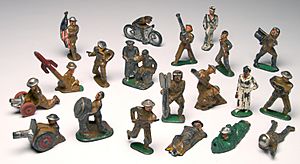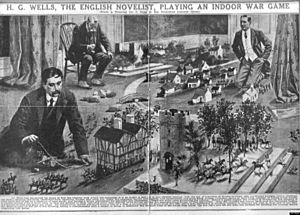Toy soldier facts for kids
A toy soldier is a miniature figurine that represents a soldier. The term applies to depictions of uniformed military personnel from all eras, and includes knights, cowboys, American Indians, pirates, samurai, and other subjects that involve combat-related themes. Toy soldiers vary from simple playthings to highly realistic and detailed models. The latter are of more recent development and are sometimes called model figures to distinguish them from traditional toy soldiers. Larger scale toys such as dolls and action figures may come in military uniforms, but they are not generally considered toy soldiers.
Toy soldiers are made from all types of material, but the most common mass-produced varieties are metal and plastic. There are many different kinds of toy soldiers, including tin soldiers or flats, hollow cast metal figures, composition figures, and plastic army men. Metal toy soldiers were traditionally sold in sets; plastic figures were sold in toy shops individually in Britain and Europe and in large boxed sets in the U.S. Modern, collectable figures are often sold individually.
Contents
Scale
- Further information: Miniature_figure_(gaming)#Scales and List of scale model sizes
| Ratio | Inches per foot | Size | Examples |
|---|---|---|---|
| 1:35 | 0.342" [8.68 mm] | 1.811" [46 mm] | Popular military modelling scale for vehicles and light aircraft (Tamiya). Also used for the accompanying human display models like crew and passengers. |
| 1:32 | 0.375" [9.525 mm] | 1.98" [50.3 mm] | Model railroad "I scale". Also used for display models. Britain's LTD toy farm sets (animals, structures, and most vehicles) and "Stablemate size" model horses were in this scale. |
| 1:30 | 0.4" [10.16 mm] | 2.125" [54 mm] 2.165" [55 mm] |
Traditional "Normal scale" lead or die-cast metal toy soldiers (Britain's LTD). |
| 1:28 | 0.423" [10.87 mm] | 2.36" [60mm] | Spanish 60mm size (actually closer to 1/26 or 1/27 scale) (Alymer Toy Soldiers). |
| 1:24 | 0.50" [12.7 mm] | 3" [76.2mm] | American "Dimestore" 3-inch size (Barclay or Manoil) or German 75mm size (actually closer to 1/21 scale). 1/2-scale dollhouses are built in this scale. |
| 1:16 | 0.75" [19.05 mm] | 4" [101.6 mm] | Used for Ertl's toy farm sets (animals, structures, and most vehicles) and most plastic toy animal figures. |
Scale for toy soldiers is expressed as the soldier's approximate height from head to foot in millimeters. Because many figures do not stand up straight, height is usually an approximation. Standard toy soldier scale, originally adopted by W. Britain, is 54 mm (2.25 inches) or 1:32 scale. Among different manufacturers, standard scale may range from 50 mm or 1:35 scale, to 60 mm or 1:28 scale. For gamers and miniatures enthusiasts, 25 mm and even smaller scales are available. On the larger end of the scale are American Dimestore figures, and many of the toy soldiers produced in Germany, which are approximately 75 mm (3 inches) or 1:24 scale.
Collecting
There is a substantial hobby devoted to collecting both old and new toy soldiers, with an abundance of small manufacturers, dealers, and toy soldier shows. There are even specialty magazines devoted to the hobby, such as "Toy Soldier Collector", "Plastic Warrior" and "Toy Soldier and Model Figure". Collectors often specialize in a particular type of soldier or historical period, though some people enjoy collecting many different kinds of figures. The most popular historical periods for collecting are Napoleonic, Victorian, American Civil War, World War I, and World War II. Many collectors modify and paint plastic figures, and some even cast and paint their own metal figures.
Actor Douglas Fairbanks Jr had a collection of 3000 toy soldiers when he sold it in 1977. Fantasy novelist George R. R. Martin has a substantial collection of toy knights and castles. The most extensive collection of toy soldiers was probably that of Malcolm Forbes, who began collecting toy soldiers in the late 1960s and amassed a collection of over 90,000 figures by the time of his death in 1990. Anne Seddon Kinsolving Brown of Providence, Rhode Island, USA, began collecting miniature toy soldiers on her honeymoon to Europe in 1930, eventually amassing a collection of over 6,000 figures; these are on display at the Anne S. K. Brown Military Collection at Brown University Library in Providence.

Some of the more noteworthy, annual toy soldier and historical figure shows include the Plastic Warrior Show, which is the oldest established show in the U.K. Beginning in 1985 and still being held annually in Richmond, South London. Another well known show is the London Toy Soldier Show held in central London (now owned and operated by the magazine Toy Soldier Collector), the Miniature Figure Collectors of America (MFCA) show in Valley Forge, the Chicago Toy Soldier Show (OTSN) in Illinois, the East Coast Toy Soldier Show in New Jersey, the West Coaster Toy Soldier Show in California, the Sammlerbörse (Collector's Market) in Friedberg, Germany and the biennial Zinnfigurenbörse (Tin Figure Market) in Kulmbach, Germany.
In recent years, collectors of vintage toy soldiers made of polythene PE and polypropylene PP thermoplastics as well as PC/ABS plastic blends have reported brittling and disintegration of collectible miniatures or components thereof.
Varieties
Different types and styles of toy soldiers have been produced over the years, depending on the cost and availability of materials, as well as manufacturing technologies. Here is a list of some of the most commonly collected varieties of toy soldiers.
- Aluminum – slush cast aluminium, made chiefly in France during the early and middle 20th Century
- Army men – unpainted, soft plastic toy soldiers sold inexpensively in bags or with terrain pieces and vehicles in boxed playsets
- Composition – made from a mixture of sawdust and glue, manufactured in Austria and Germany
- Connoisseur – high quality, collectible figures featuring highly detailed paint jobs
- Dimestore – hollow or slush cast iron, sold through five and dime stores from the 1920s to 1960 in the United States
- Flat – thin, two dimensional tin soldiers cast in slate molds
- Hollow cast – cast in metal, usually a lead alloy, which cools and sets as it touches the mold; the excess molten metal is poured out leaving a hollow figure
- Paper – printed on sheets of paper or cardboard, frequently mounted on blocks of wood
- Plastic – hard and soft plastic, generally painted figures
- Solid – cast in solid metal, usually lead, common in Germany during the 19th and early 20th Century
- Wood - From the 19th century Germany produced large amounts of wooden fortresses and toy soldierssometimes working on a scissors mechanism .
Prominent vintage toy soldier makers include Airfix, Barclay, Britains, Herald, Elastolin, Johillco, Lineol, Marx, Manoil, Reamsa and Timpo.
Gaming
The playing of wargames with toy figures was pioneered by H. G. Wells in his 1913 book, Little Wars. Wells, a pacifist, was the first to publish detailed rules for playing war games with toy soldiers. He suggested that this could provide a cathartic experience, possibly preventing future real wars. Although this was not to be, Little Wars was a predecessor to the modern hobby of miniatures wargaming. According to Wells, the idea of the game developed from a visit by his friend Jerome K. Jerome. After dinner, Jerome began shooting down toy soldiers with a toy cannon and Wells joined in to compete.
A similar book titled Shambattle: How to Play with Toy Soldiers was published by Harry Dowdall and Joseph Gleason in 1929.
Although people continue to play wargames with miniature figures, most contemporary wargamers use a smaller scale than that favored by collectors, typically under 25 mm.
See also
 In Spanish: Soldado de juguete para niños
In Spanish: Soldado de juguete para niños




